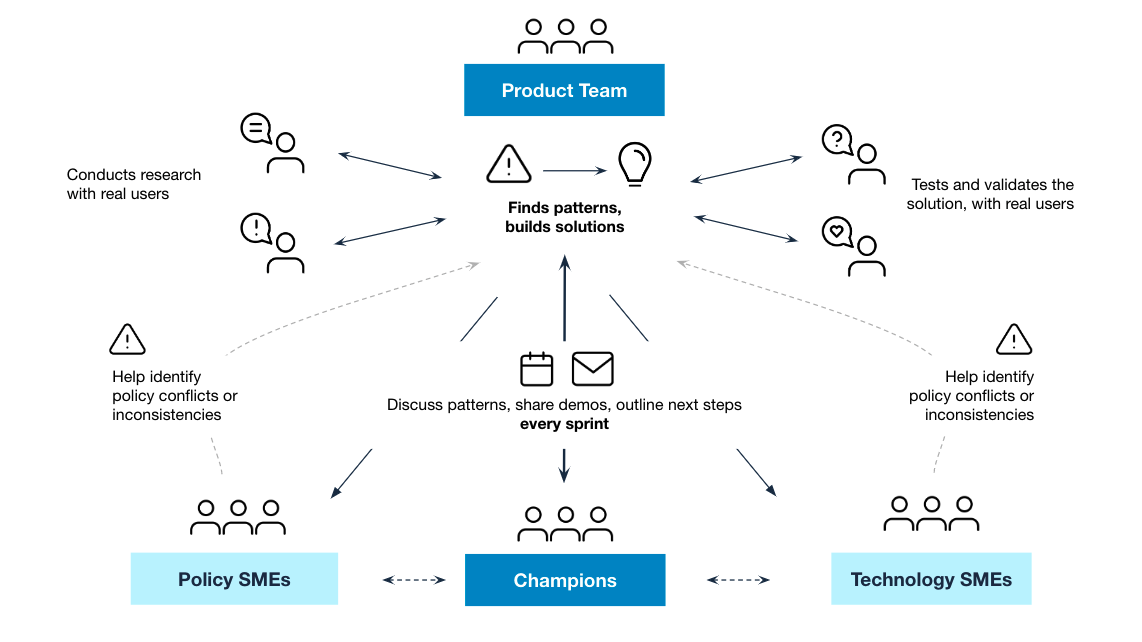This series examines how teams need to work closer with senior executives as allies. (see part 1)
Senior executives often have to make big decisions early because of the long budget and planning cycle in the federal government. But modern software design requires making incremental decisions over time to be able to adjust plans as things change. Having frequent and direct conversations between senior executives and the product team makes it easier to make smaller and less risky decisions.
This diagram demonstrates how a product team and a champions group of senior executives might maintain these direct interactions (see part 3 for a definition of a product team and champions group):

- The product team conducts user research regularly and leverages that information to direct all product decisions.
- The champions are updated every sprint (via weekly ship emails and demos) and advise on the best path forward, given their knowledge of organizational enablers and risks.
- Organizational subject matter experts (SMEs) within offices of your chief information officer (OCIO), security (ISO), general counsel (OGC), procurement, or accessibility, are also updated monthly and can be available for resolving policy or technology blockers.
As Daniel Yi, Senior Counsel for Legal Innovation at the Department of Justice (DOJ), puts it, “create a touchpoint every few weeks that brings the team together with the key decision makers – people who can give top cover to 99% of the choices facing the team. The decision makers need to be ready to give as much clarity as possible. And the team needs to be ready to go with the key questions that the decision makers are best positioned to answer.”
In addition to these recurring touchpoints, it’s important for a product team to go out of their way to ask senior executives for their feedback or experience, not necessarily a decision. Large meetings should never be the first time a champion hears updates from the product team. These recurring touchpoints are a valuable backchannel to get feedback from leaders before facilitating a larger meeting with them where decisions will be made.
As a product team, we often get feedback from various stakeholders on specific, strategic points before proposing a recommendation. For example:
- We asked leaders of FNS SNAP Quality Control Branch and FNS Office of Information Technology to weigh in on the primary users we should focus on.
- We asked an executive of DOJ’s Civil Rights Division to prioritize which content to start writing or migrating over to their knowledge management system.
- We asked various judges of the US Courts to discuss different technical approaches to building a case management system.
Gathering data, including experiences or feedback, across all stakeholders (user, organization, technology, and especially senior executives) will position the product team as an unbiased advocate. Early on, when the priorities and definition of success are ambiguous, it’s important to have more frequent planning sessions (every 2 weeks or sprint) between product team and senior stakeholders. Then, as the product team builds momentum, milestone planning discussions and decisions with senior executives can happen less frequently (every 1-2 months) as the roadmap priorities change or mature. By regularly showing your work and getting feedback from senior executives , product teams will earn senior executives’ trust, and therefore be empowered to make strategic decisions.
Daniel Yi has learned why this approach matters: “A lot of executives in government have been burned by failure to deliver on expectations. It’s hard for them to just trust the team. You have to build their confidence. The question in their mind will always be ‘do they have better knowledge and skills to make the call than me?’ You need to win their respect and convince them that this team knows how to do this better than them.”

